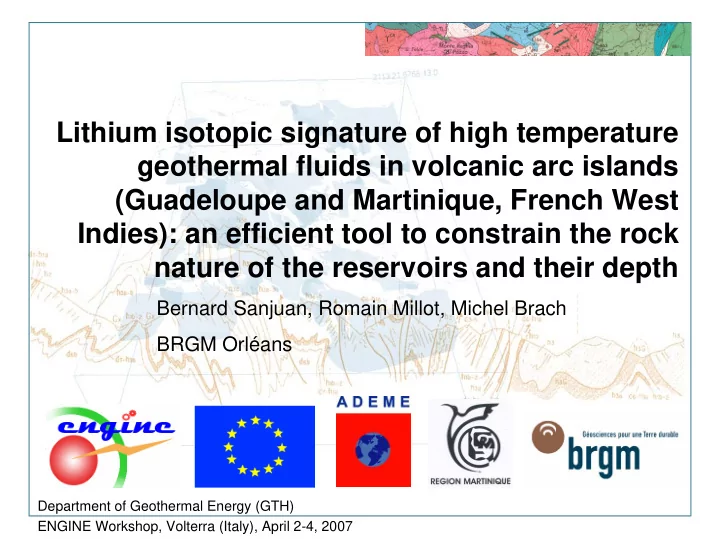

Lithium isotopic signature of high temperature geothermal fluids in volcanic arc islands (Guadeloupe and Martinique, French West Indies): an efficient tool to constrain the rock nature of the reservoirs and their depth Bernard Sanjuan, Romain Millot, Michel Brach BRGM Orléans Department of Geothermal Energy (GTH) ENGINE Workshop, Volterra (Italy), April 2-4, 2007
Framework and main objective of this study > Numerous geochemical tools for geothermal and thermal waters, fumaroles or gas escapes are commonly used to study and better understand the high temperature geothermal reservoirs (fluid circulation - fluid residence time - chemical, isotopic or gas geothermometers, for example) > However, few present geochemical tools are available to constrain the rock nature of these reservoirs and their depth, without no sampling and analysis of reservoir rocks nor direct access by drilling > In this study, we have investigated if the δ 7 Li values measured in hot waters collected from deep production wells (Bouillante geothermal field, Guadeloupe) and thermal springs (Diamant geothermal exploration area, Martinique) could be used to constrain these parameters Department of Geothermal Energy (GTH) > 2 ENGINE Workshop, Volterra (Italy), April 2-4, 2007
Experimental data of seawater/basalt interactions at temperatures ranging from 25 to 250°C > Experiments at different temperatures (25, 75, 200, 250°C) > Use of reference material (basalt and seawater) > Seawater diluted at 60% y = 7.79 x - 7.85 r = 0.92 y = 7.79 x - 7.85 r = 0.92 and seawater/basalt mass ∆ : Li isotopic fractionation ratio of 10 between solution and solid > Run durations (7 to 12 days at 200 and 250°C and y = 7.60 x - 8.39 y = 7.60 x - 8.39 245 days at 25 and 75°C) > Heavy 7 Li isotope is preferentially released into solution (19.5‰ at 25°C and 6.8‰ at 250°C) Department of Geothermal Energy (GTH) > 3 ENGINE Workshop, Volterra (Italy), April 2-4, 2007
Main results obtained in this study > Using the experimental data obtained in this δ 7 Li study, the values analyzed in the geothermal fluid (4.4 ± 0.3‰ for Bouillante and 6.5 ± 0.3‰ for Diamant) and the reservoir temperatures (250-260°C measured for Bouillante and 180°C estimated for Diamant), a value of δ 7 Li = -2.6 ± 0.5‰ is found for the isotopic signature of the reservoir volcanic rocks > This value suggests that the main geothermal reservoirs of Bouillante and Diamant are located in the transition zone that marks the contact between volcanic flows and basaltic dikes and is a region of fluid mixing. In the Bouillante site, this zone is probably present at a depth of about 3-4 km 35 seawater hyperbolic curve representing the mixing 30 between geothermal fluid and seawater 7 Li values (‰) 25 20 15 sub-marine thermal 10 geothermal reservoir fluid springs > For the Bouillante site, the δ 7 Li values confirm the δ δ 7 Li = 4.4 ± 0.3‰ 5 homogeneity of the geothermal fluid composition and the existence of a common and large reservoir 0 0,00 0,50 1,00 1,50 2,00 2,50 3,00 3,50 4,00 4,50 Li/Cl (mass ratio) x 10 4 Department of Geothermal Energy (GTH) > 4 ENGINE Workshop, Volterra (Italy), April 2-4, 2007
Main conclusions > This study shows that the Li concentrations and δ 7 Li values analyzed in the hot fluids can be used not only to identify geothermal reservoirs and estimate their temperature but can also be a powerful tool to constrain the nature and the type of the reservoir rocks (and indirectly the reservoir depth) > Additional water/rock interaction experiments (fresh water/basalt, seawater and fresh water/andesite, etc.) similar to those presented in this study and more isotopic Li data on the hot fluids of other geothermal reservoirs are necessary to complete this study and improve our understanding of Li behavior in island arc geothermal systems Department of Geothermal Energy (GTH) > 5 ENGINE Workshop, Volterra (Italy), April 2-4, 2007
Recommend
More recommend